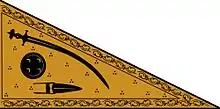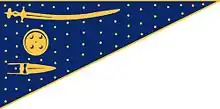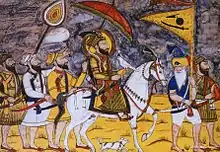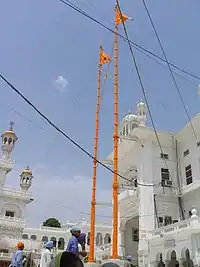Nishan Sahib
The Nishan Sahib is a Sikh triangular flag made of cotton or silk cloth, with a tassel at its end. The word, Nishan Sahib means exalted ensign, and the flag is hoisted on a tall flagpole, outside most Gurdwaras. The flagpole itself, covered with fabric, ends with a two-edged dagger (khanda) on top. The emblem on the flag is also known as Khanda, which depicts a double-edged sword called a khanda (☬) in the centre, a chakkar which is circular, and flanked by two single-edged swords, or kirpans.In the centre of the insignia is the two-edged sword which symbolises the Creative Power of God that controls the destiny of the whole universe. It is the Sovereign Power over life and death. One edge of the Sword symbolises divine justice, which chastises and punishes the wicked oppressors; the other edge symbolises Freedom, and Authority governed by moral and spiritual values.

On the outside of the two-edged sword, we can see two swords:
- On the left is the Sword of Spiritual Sovereignty (Piri);
- On the right is the Sword of Political Sovereignty (Miri)
There must always be a balance between the two, and this balance is emphasised by a circle inside. This circle is what is called a Chakra or Chakkar. The Chakra is a symbol of all embracing Divine Manifestation, including everything and wanting nothing, without beginning or end, neither first nor last, timeless, and Absolute. It is the symbol of oneness, of Unicity of Justice, Humanity, and the Immortality. Almost all Sikh warriors used to wear it in the eighteenth century, and Nihangs of today still do. The Khanda Sahib is not to be confused with the Nihang's Aad Chand which was the first symbol of the Khalsa.
Traditional symbol of the Khalsa Panth (corps of initiated Sikhs), the Nishan Sahib can be seen from far away, signifying the presence of Khalsa in the neighbourhood. It is taken down every Baisakhi (harvest festival, mid-April in the Gregorian calendar and first in the Nanakshahi calendar), and replaced with a fresh flag, and the flagpole refurbished.
History





During the times of Guru Amar Das the Nishan Sahib was white, to represent peace and simplicity. During the time of Guru Hargobind, however the Nishan Sahib mas made into a shade of yellow, known as Basanti, to show the spirituality of the Sikhs and their warrior spirit. After the creation of Khalsa, Guru Gobind Singh introduced Navy Blue (called Surmayee) flag, which is still the colour of the Nihang flags. The first Sikh flags were plain, but emblems were introduced by Guru Gobind Singh. The first Sikh emblem, was not the Khanda, but the three weapons, the Kattar (dagger), Dhal (shield) and Kirpan (sabre). Later these emblems were also used by the Sikh misls and the Empire.

When Gulab Singh asked Maharaja Ranjit Singh to change the Nishan Sahib to saffron or deep orange Maharaja Ranjit Singh declined but later when he changed the army from traditional Akalis to French-style soldiers he made separate flags to respect Hindu and Muslim[1] ideologies. Later the Battle standards for Muslim regiments was the Lion and the Sun and the Hindu Regiments were various gods and goddesses.

Later during the British Rule it became from Basanti and Surmayee to Kesari and Surmayee due to the Hindu Mahants, Nirmalas and lack of historians. This influenced Sikhism a lot and it became the Kesri Nishan Sahib with a peacock feather on top.
During the Singh Sabha Movement the Sikhs tried to restore Sikhism to its pristine glory so in the start it became the Flag of the Dal Khalsa but slowly it changed to the today's Nishan Sahib with the Khanda Emblem.
Weapons and ornaments
The original Nishan Sahib carried by Guru Gobind Singh ji in the Kattar, Dhal, Kirpan format had either a ashtabhuja, nangini barcha or Karpa Barcha used as a spear on top. The Nagni Barcha or snake like sword was created by Guru Gobind Singh ji and famously used by Bhai Bachittar Singh to pearce the trunk of a drunken, armored elephant in the Battle of Nimolgarh. The Ashtabhuja is a spear with three crescents stuck to an iron rod with two spears coming out on top. The Ashtabhuja was used by Hindu goddess Durga many times but Durga does not hold any relevance in Sikhism and is only used for warfare. Guru Gobind Singh Ji's ashtabhuja was found in Chamkaur the place where his two sons were martyred and other two captured with his mother. The Gajgah is the frontal head piece made from Steel. It represents the Shakti of Akal Purakh (God). It is preserved and revered at Sachkhand Hazur Sahib. The flag is simply wrapped around the top of the spear with two strings of fabric coming out of the tip.
While today's Nishan Sahib has a Khanda in a dagger form on top of the flag and the fabric covering the spear till the top. The Khanda symbol is also relatively new and was made in the early 19th century.
Overview
The Nishan Sahib is placed outside most Sikh Gurdwaras and is supported by a pole of timber or metal.
The Khanda, a Sikh symbol, today, is rendered in navy blue on the saffron background while the original was basanti( bright yellow) and surrmai neela ( Royal blue). The khanda is placed high up on a flagpole as a sign for all Sikhs and indeed any other people that they can come and pray in this building. Great respect is shown to this flag[2] and the flag is considered sacred and washed using milk and water every year[3] in April at the festival of Vaisakhi. The Nishan Sahib is changed once the saffron color has faded.
Gallery

 Nishan sahib Golden Temple
Nishan sahib Golden Temple
 Nishan Sahib, Sikh religious flag hoisted outside the Gurdwaras
Nishan Sahib, Sikh religious flag hoisted outside the Gurdwaras
Like a Flag of any institution, this Flag symbolizes the presence of the Khalsa and hence is hoisted at every Gurdwara premises. Therefore, anybody in need of help, however with the Khalsa now being in non-war status, but always functional, the Gurdwaras serve the purpose of congregational meeting, Langar and lodging.
References
- "r/Sikh - A fortified Sikh encampment at Ferozeshah, awaiting the arrival of the British forces, first Anglo Sikh war, 1845". reddit. Retrieved 2020-10-02.
- William Owen Cole; Piara Singh Sambhi (1998). The Sikhs: Their Religious Beliefs and Practices. Sussex Academic Press. p. 58. ISBN 978-1-898723-13-4. Retrieved 30 December 2012.
- Eleanor M. Nesbitt (2004). Intercultural Education: Ethnographic and Religious Approaches. Sussex Academic Press. p. 77. ISBN 978-1-84519-033-0. Retrieved 30 December 2012.